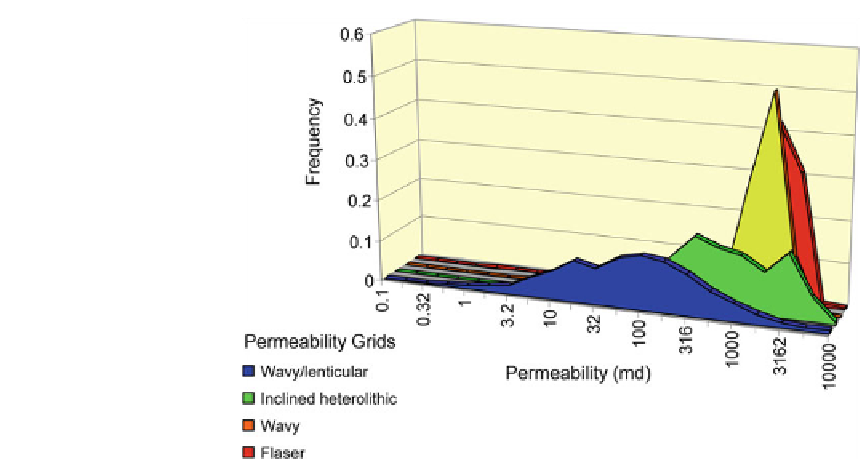Geoscience Reference
In-Depth Information
Fig. 3.17
Probe
permeability datasets using
a 2 mm-spaced
measurements on a 10 cm
grid of reservoir core slabs
from facies in a tidal deltaic
reservoir unit
Whatever the nature of the underlying
distributions in a reservoir dataset, we should
bear in mind an important principle embodied
by the
Central Limit Theorem
which can be
summarized as follows:
very close to the true population statistics. This is
in conflict with the Data
Truth axiom. It is
preferable to control and select the transforms
being used, and only employ the Normal Score
Transform when clearly justified. The selection
of the model elements (Chap.
2
) is the first step
to deconstructing a complex distribution, after
which the normal score transform may indeed
be applicable: one for each model element.
Two examples of something close to “true”
reservoir permeability distributions are shown in
Fig.
3.17
. Here, exhaustive probe permeability
datasets have been assembled using a 2 mm-
spaced measurements on a 10 cm grid of reser-
voir core slabs from facies in a tidal deltaic
reservoir unit. In one case, the permeability dis-
tribution is close to log-normal, while the others
they are clearly not - more root normal or multi-
modal.
With more conventional data sets (e.g. core
plug sample datasets), we also have the problem
of under-sampling to contend with. Figure
3.18
shows three contrasting core plug porosity
datasets. The first (a) could be successfully
represented by a normal distribution while the
second (b) is clearly neither normal nor log-
normal. The third (c) is a typical under-sampled
dataset where the user needs to infer a 'restored'
porosity distribution.
6
¼
The distribution of sample means from a large
number of independent random variable usually
approximates a normal distribution regardless of
the nature of the underlying population distribution
functions.
For example, let us assume we have N wells
with permeability data for a given reservoir
unit. For each well, we have observed
distributions of k which appear to be approxi-
mately log-normally distributed (a common
observation). However, the distribution of the
average well-interval permeability between
wells (the mapped parameter) is found to be
normally distributed. This is quite consistent,
and indeed for a large number of wells this is
expected from Central Limit Theory. Similar
arguments can apply when upscaling - fine-
scale permeability distributions may be quite
complex (log-normal or multi-modal) while
coarse-scale distributions tend towards being
normally distributed. An important constraint
for the central limit theorem is that the samples
should
be
statistically
independent
and
reasonably large.

